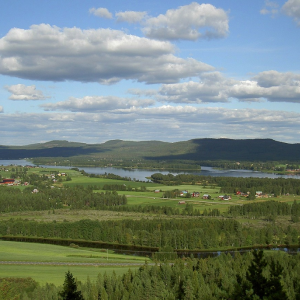
This paper, co-authored by Table member Georg Andersson, evaluates the trade-offs between greenhouse gas emissions, calorie output and biodiversity for several farm types in Sweden. It finds that while no one farm type maximises on-farm performance for all categories simultaneously, there is potential to manage the trade-offs, for example by reducing the land used for dairy farming in favour of both cropping for food production and extensive livestock grazing.
The figure below compares six impact categories for five farm types. (For a discussion of why “landscape openness” was chosen as a measure of landscape aesthetic value, see section 2.4 of the original paper.) Based on this analysis, the authors recommend that using arable land for food production, as opposed to feed production for dairy cattle, could increase food production and decrease greenhouse gas emissions. However, while field crops produce the most calories per hectare and per unit of greenhouse gas emission, they also have the lowest performance on other impact categories (area of the farm having high value to nature, landscape openness, and plant biodiversity measured by certain grassland indicator species).
Image: Figure 7, Olén et al. Comparison of ecosystem services for Dairy, Field Crop, Granivores, Grazing Livestock, and Mixed farms. The circle centre (minimum) represents the 5th quantile and the outer circle (maximum) the 95th quantile of the service. We present unweighted values since the relative importance of different ecosystem services can depend on the stakeholder/reader point of view. Note that an increased emission per hectare is a disservice since an increase represents an additional release of GHG.
The paper notes that reducing livestock consumption could contribute to reducing agricultural land use and greenhouse gas emissions, but that switching entirely to plant-based diets could reduce grassland biodiversity in Sweden because of species richness in semi-natural grasslands maintained by livestock grazing. The paper does not measure the climate impacts of converting between land uses types, such as emissions from ploughing up a meadow for cropland.
The paper does not discuss off-farm biodiversity in detail. For more information on the debate between preserving biodiversity on farms or by freeing up land for rewilding/conservation, see the Table explainer What is the land sparing-sharing continuum?
Abstract
Context
The global demand for food is expected to continue increasing for decades, which may drive both agricultural expansion and intensification. The associated environmental impacts are potentially considerable but will depend on how the agricultural sector develops. Currently, there are contrasting regional developments in agriculture; expansion and/or intensification in some regions and abandonment in others, as well as changes in the type of farming. However, the environmental consequences of changes in farm type are not well understood.
Objective
We have evaluated the impacts of farm type on food production and three key environmental variables—landscape openness, grassland biodiversity and greenhouse gas (GHG) emissions—in three marginal agricultural regions in Sweden.
Methods
We do this by first dividing the population of farms in each region into types, based on their land-use and livestock holdings using an innovative clustering method. Thereafter we analysed changes in production activities for farm types over time and evaluated the environmental and food-production impacts, where landscape openness is quantified using a novel indicator.
Results and conclusion
Our results show that there is not one single farm type that would simultaneously maximise food production, grassland biodiversity, and landscape openness, whilst minimising GHG emissions. However, there exists considerable potential to manage the trade-offs between food production and these environmental variables. For example, by reducing land use for dairying and instead increasing both cropping for food production and extensive livestock grazing to maintain landscape openness and biodiversity-rich semi-natural pastures, it would keep food production at similar levels.
Significance
Our farm typology allows us to assess the multifunctionality of farming, by relating contrasting production activities to multiple ecosystem services, grassland biodiversity and GHG emissions for informing policy towards more sustainable agriculture. We have demonstrated this with examples under Swedish conditions, but it should to a large extent also be applicable for other countries.
Reference
Olén, N.B., Roger, F., Brady, M.V., Larsson, C., Andersson, G.K., Ekroos, J., Caplat, P., Smith, H.G., Dänhardt, J. and Clough, Y., 2021. Effects of farm type on food production, landscape openness, grassland biodiversity, and greenhouse gas emissions in mixed agricultural-forestry regions. Agricultural Systems, 189, p.103071.
Read the full paper here. See also the Table explainer What is the land sparing-sharing continuum?







Post a new comment »